

A column in The Oberlin Review, “Off the Cuff,” relates an interview with Les.
The first premise is that, in light of the tens of thousands of children dying of preventable causes each day, and the outrageous number of species going extinct due to our excessive breeding, the intentional creation of one more of us by anyone anywhere can’t be justified today.
The second is that our species, Homo sapiens, is incompatible with Earth’s biosphere and, for the sake of all other life, we should voluntarily phase ourselves out.
VHEMT Supporters agree with the first premise but don’t think we should go all the way to extinction. Maybe when we get down to a sustainable number we can rethink our breeding choices.
VHEMT Volunteers, like myself, think that as long as there’s one breeding pair of us, there’s too great a risk of our getting right back to where we are today. It was only about 73 thousand years ago that we numbered fewer than 10 thousand, certainly a sustainable number.
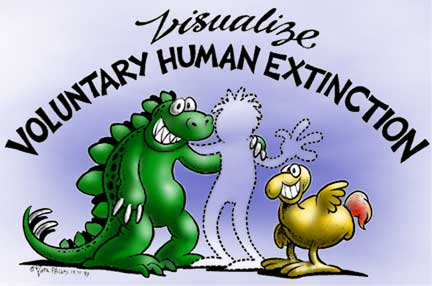
It starts with a vision. A few of you may be wondering why we think our species should be phased out. Why do we think Homo sapiens should join the dinosaurs and the dodo?
People arrive at this conclusion from several routes, often independent of VHEMT. I hear from people around the planet who are happy to find out they’re part of a larger movement. They thought they were the only ones who followed a train of logic, guided by compassion, to arrive at the conclusion that humanity should go extinct. There must be millions of us who have figured this out.
Most have never heard it called the Voluntary Human Extinction Movement and never will—they don’t speak English. It won’t surprise me to learn of a group with a similar name in another language which evolved independently. It’s an idea whose time has come, though it may be a little late.

Most of us started down this path out of a concern for Earth’s other 10 to 100 million species sharing the biosphere. We don’t know how many species there are. We’ve only identified about two million.
People concerned about the environment quickly become aware that every threat to natural ecosystems comes from humans, and that the more of us there are the worse it gets. This was my experience.

Why are we deforesting the planet? We need more wood and more farmland because there are more of us. Environmentalists generally agree that fewer humans would make preserving and restoring ecosystems easier, and that our increasing numbers converts wildlife habitat into human habitat.

Wherever we live, not much else lives.
Polls show that most North Americans consider themselves environmentalists -- concerned about our environment. However, this concern has a wide range, and I’ve designed a simple chart to help people find out how deep their ecology is.
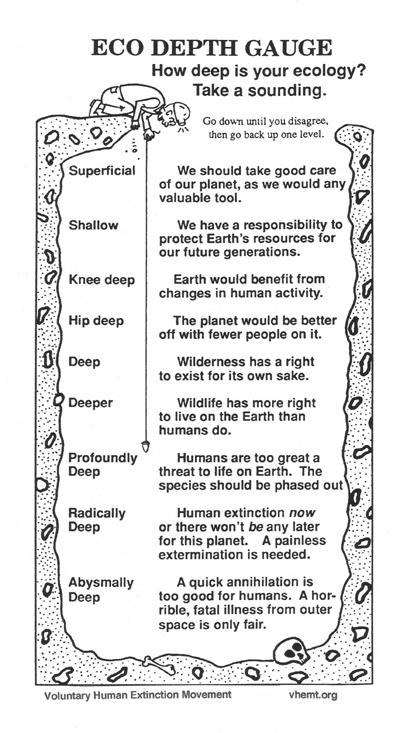
Concern for non-human animals is another, nearly parallel route to vehemence.
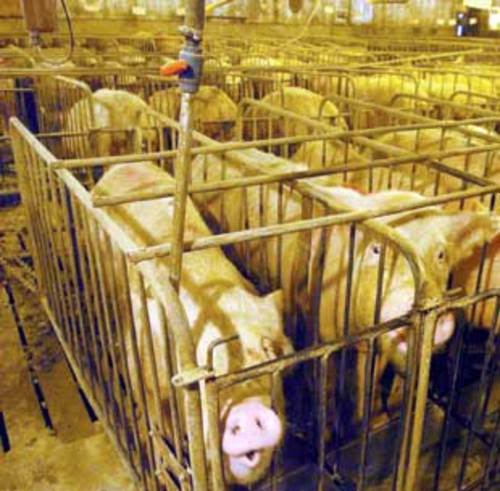
People become aware of our mistreatment and exploitation of other animals, especially domesticated animals, and change their habits to become more humane. At first it’s fairly easy: we just stop eating meat, start treating the family dog nicer, and give up hunting a few days of the week. We might become vegan and give up drinking milk, what some call liquid meat. It quickly gets more complicated as we try to avoid all animal products. Cars kill more animals than hunting, so do we stop driving? I kill the slugs in my garden that try to eat my salad greens—it’s a humane slaughter, I swear.
We might also work to increase awareness of non-human animal exploitation, encourage friends to eat less meat,

—form an animal rights group and bring radical kooks from across the country to share wacky ideas.
After a while this path meets up with environmentalists: humans are the underlying problem. Even if we live the most life-friendly lives, other animals are going to be harmed just by our existence.
One of those animals harmed is us. There are two lesser-travelled paths to vehemence—human-centered paths:
German philosopher Arthur Schopenhauer wrote,
“If children were brought into the world by an act of pure reason alone, would the human race continue to exist? Would a man rather have so much sympathy with the coming generation, as to spare it the burden of existence? Or at any rate not take it upon himself to impose that burden upon it in cold blood.”
Today we probably live better than the average human did in 1851, and I don’t feel that my life is more suffering than pleasure, but many of us in VHEMT feel that the future isn’t what it used to be. Setting out to bring another of us into existence today could be considered the moral equivalent of renting out rooms in a burning building. Something to consider anyway.
In Kurt Vonnegut’s last interview, he expressed his feeling that we treat each other so badly that we deserve to go extinct. His experience in World War Two affected him deeply, and there hasn’t been a significant lessening of inhumanity to humanity since then.
So, we’re motivated by concern for the biosphere as a whole, and concern for the rights of animals both human and non-human.

Along all of these paths is a sense of fairness, of justice. Our innate sense of what’s right reveals to us what’s wrong, and if we allow ourselves to think through our culturally-induced roadblocks, there’s a good chance we’ll all arrive at the same conclusion.
Lady Justice holds a balance scale to judge two sides. If we place all the species going extinct because of us on one side, and place us on the other side, the verdict will be obvious. We might add a little weight to our side because we’re smart enough to know she’s blind while the other species are too dumb to cheat. But still, even giving us a hundred thousand times the weight of any other species, that sword will be pointed at us. If her verdict involves vasectomies let’s hope she takes off the blindfold.
How do we bring this vision of phasing out our species to reality?

Other exotic invaders have proved difficult if not impossible to eradicate. He’s baiting the cat trap with cheeseburger. In Portland, where I live, feral house cats are devastating song bird populations, so the Feral Cat Coalition traps, sterilizes, and releases them. They make a notch in one ear so if they’re caught again they don’t operate—just turn them loose. Now, obviously, this won’t work for humans. I mean, an ear notch would just become a fashion statement. And besides, we’re looking for voluntary methods.
Colonizing space has been seriously suggested as a means of solving our population density problem. To hold our population steady at six point eight billion, 100 space ships each holding 2,000 people would have to blast off every day: one every 15 minutes.
It costs about 10 thousand dollars to launch a pound of anything into space, so compared with the cost of contraceptives...
There is some good news: our fertility rate has dropped from nearly five in 1950 to around 2.6 today. The bad news is that we are increasing by twice as many as 1950. Twice the growth with half the fertility, just because there are so many more of us.
But, what is causing this improvement and how do we enhance it?
Improving people’s standard of living is supposed to improve birth rates. We want to believe it so much that it’s become accepted without question.
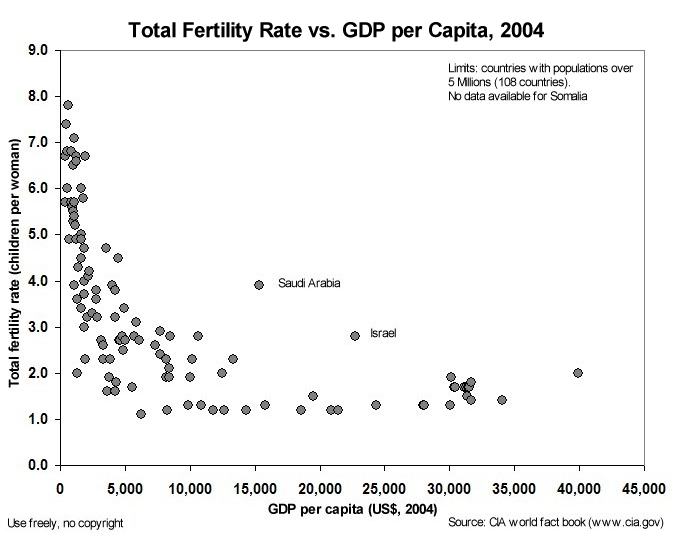
As this graph from the CIA shows, the higher the gross domestic product, the lower the fertility rate. All we have to do is develop the under-developed and they’ll be more like us. Send in the IMF, the World Bank, and the WTO. Capitalism will fix ’em right up.
But what if we’re looking at this correlation backwards? Maybe high birth rates are the cause of low per capita GDP. As we know, correlation doesn’t prove causation. There may be other factors involved which are more important than economics.
If economic incentives to encourage breeding are effective, maybe economic incentives to discourage breeding will work. As it turns out, they don’t work over the long run, except maybe in France where benefits are so generous that a career can be made of child production. A few local trial programs paying girls to not get pregnant have been successful, but funding always runs out, as does support.
Lowering infant and child mortality should help. Common wisdom tells us that couples will have six kids if three are likely to die. An outrageous number of children in our human family are dying, and we have a moral obligation to do more to ameliorate this deplorable situation. However, statistics don’t show an improvement in birth rates following improved infant mortality.
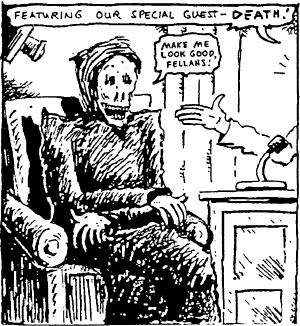
Okay let’s take a brief look at death. It’s not voluntary, which is the first word in VHEMT. Except in Italian where it’s the last word. Still, I think we should take an unbiased and objective look at why it’s so stupid.
Morality aside, high death rates cause high birth rates. People who have lost family members want to replace them. Rwanda, for example: herders and farmers got along just fine until a shortage of land for crops and grazing, coupled with European intervention, caused a horrific genocidal war in 1994. An estimated million people were killed. Now their fertility rate is more than five and government efforts to set a maximum of three children are getting nowhere. Rwanda is predominantly Christian, and more than half are Catholic, so there’s additional resistance to limiting population growth.
War, famine, disease—in most cases these are the results of excessive human population density. They have rarely been the solution in the past. In order for death to keep the human population even, 200 thousand more of us would have to die each day. We can achieve the same results humanely by preventing 200 thousand conceptions.
Which brings us to contraceptives.
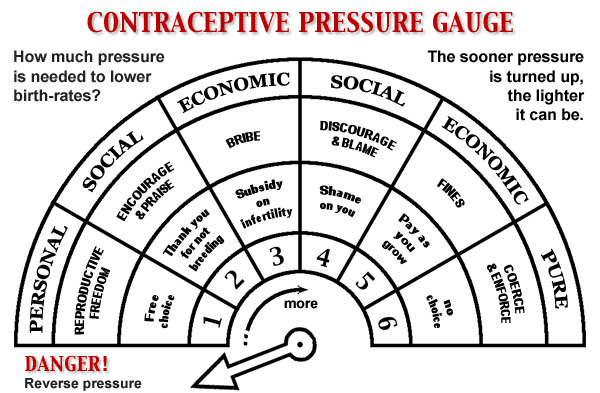
Nothing prevents conception like contraception. I made this contraceptive pressure gauge to help understand attitudes about contraception—how far would people be willing to go if they were ruler of the world. The sooner the pressure is turned up, the lighter it can be and still be effective.
Presently, we are a long way from reaching the first level.
Reproductive freedom. Where everyone who doesn’t want to conceive has the means to avoid it. Every child would be a wanted child.
Encouragement and praise. We praise people who choose not to breed.
Economic encouragement. We bribe people to not breed.
Social discouragement. We shame people into not breeding.
Economic disincentives. We fine people if they breed.
And lastly, just pure pressure. Coercion and force. No choice
For quite a few years I surveyed visitors to my information table and the results consistently averaged 3.5. The point where positive pressure becomes negative pressure.

Education of girls and women is being suggested more and more lately. This means more than just education in the use of contraceptives, which is an integral part of contraceptive services. I was on a population panel where a panelist told a story of how reproductive health care workers went to an African village and explained to the women how to use a condom. They demonstrated by putting one over a piece of wood. Six months later, there was no change in the number of unwanted pregnancies. They found that the women had put a condom on a stick and placed it at the door of their hut to ward off pregnancy.
I doubt this story’s true. It’s like the urban legend about the woman who used contraceptive jelly on her toast and sued because she got pregnant. Didn’t happen.
These condescending stories aside, statistics do show that the more education a female has the fewer children she’ll have. So, if the UN would confer an honorary college degree on all women, birth rates would drop to around two. In fact, they should give them doctorates because those women often don’t have children at all.
Okay, it wouldn’t work, but why wouldn’t it work? It’s because an education does no good if there’s no opportunity to use it. The more important factor is the status of women in society. Education level is just one of the positive results of increased status. Opportunities to pursue a variety of interests beyond wife and mother are more critical to liberating women than formal education. Education is simply one of those opportunities.
Providing education for girls does increase the status of women in that society, so it’s a positive feedback loop.
International declarations which include reproductive rights have advanced over the past 60 years.
Article 16 of the UN Declaration of Human Rights 1948 states: “Men and women of full age, without any limitation due to race, nationality or religion, have the right to marry and to found a family.”
It recognizes our right to breed, but doesn’t specify our right to not breed. Maybe it should include our right to find a family, through adoption and other non-traditional relationships.
The United Nations Convention on the Elimination of Discrimination Against Women or CEDAW, was finally adopted in 1979 by the UN General Assembly. It’s often described as an international bill of rights for women.
Article 10 Recommends access to specific educational information to help to ensure the health and well-being of families, including information and advice on family planning.
Article 16 Says that women should have the same rights to decide freely and responsibly on the number and spacing of their children and to have access to the information, education and means to enable them to exercise these rights.
It includes the right to determine the number of children, and since zero is a number, the right to not breed may be implied.
The United Nations International Conference on Population & Development in Cairo in 1994 was more specific about women’s rights. It states that:
“Advancing gender equality and equity and the empowerment of women, and the elimination of all kinds of violence against women, and ensuring women’s ability to control their own fertility, are cornerstones of population and development-related programmes. The human rights of women and the girl child are an inalienable, integral and indivisible part of universal human rights. The full and equal participation of women in civil, cultural, economic, political and social life, at the national, regional and international levels, and the eradication of all forms of discrimination on grounds of sex, are priority objectives of the international community.”
This is a significant advancement from CEDAW. Rather than women having the same rights as their partners to determine the number of children they produce, this one declares a woman’s right to control her fertility.
Secretary of State Hillary Clinton reaffirmed a commitment to these goals in her speech last month.
One last agreement. In 2000, Millennium Development Goals were agreed upon at the United Nations. They don’t mean that’s how long it’ll take, but progress lags in most of these goals.
Improving population density isn’t one of the stated goals—maybe some day—but goals three and five would help significantly.
Now, all we have to do is implement these agreements. Promoting gender equality is the single most important issue influencing birth rates. If women aren’t allowed to exercise their right to choose how many children they raise, contraceptives are nearly useless. In societies where women have the lowest status, birth rates are highest.
Let’s go back to that money and breeding chart.

If we substitute status of women for Gross Domestic Product, this chart would remain largely unchanged. In these societies, women often must choose between risking their lives by using contraception, or risking their lives and the lives of their children by not using it.
More than 200 million couples want contraceptive services and can’t get them. The freedom to exercise our basic human right to not breed is being denied, with tragic results. There’s far more interest in preserving our right to breed than our right to not breed. China’s one-child policy is almost universally condemned, and yet coercing couples to have children they don’t want causes much more suffering than denying couples their right to produce as many as they want.
Roughly 75 million women are impregnated against their wishes each year. 50 million pregnancies are not carried to term, but 25 million children are born to couples who don’t want them. Unwanted births are not a simple matter of personal preference. When existing children are hungry, adding another life can mean death.
Gender equality is a good in itself, and in the past few years, population activists, who are predominately male, have increasingly acknowledged the importance of improving women’s status in society.
I realize this is sexist, but it seems to me that men tend to see the world as a big machine that can be tinkered with until it runs smoothly. The baby-making component has been over-producing so adjustments need to be made. Women with more education have fewer children, so let’s educate them. We can provide them with micro loans for home businesses, create employment outside the home, provide reproductive health services and give them contraceptives.
As potentially good as these may be, they are all things done to or for women. Even empowerment sounds patronizing to me, though maybe I’m reading too much into the term. How about we just stop the institutionalized suppression and oppression of women?
The treatment of women today ranges from unfair, in our country, to horrific. If such unequal treatment were based on race instead of gender, we wouldn’t stand for it.
A few years ago the Census Bureau released a report showing an increase in women remaining childfree. A reporter with the Washington Post asked me why, and I said the main reason is because they can. That wasn’t included in the published article—they wanted to find reasons like, too focused on career and inability to find the right partner in our busy lives. Advancement of women’s rights wasn’t something they had in mind.
A woman’s right to control her fertility is something we take for granted in North America. Although there are a few vocal fringe groups opposing contraception, it’s legal if you can afford it and if your pharmacist will let you have it. However, there’s a tremendous amount of social pressure on both men and women to procreate.
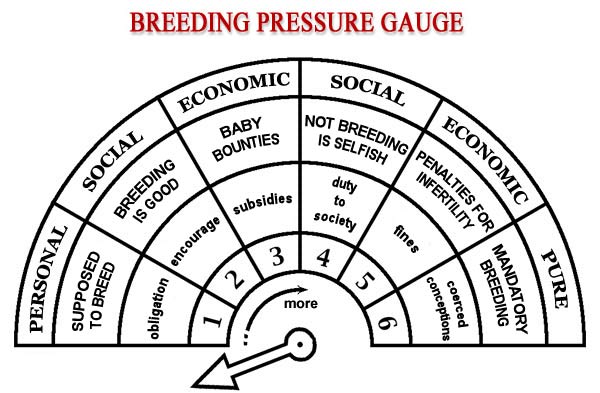
Some of you might recognize the pressure to breed which you’re forced to endure. I blame my chromosomes for this mechanistic view of the world.
1. Personal pressure. Cultural conditioning to procreate begins early and continues insidiously into adulthood. It’s so strong that most of us have never considered not breeding. It’s so pervasive that we don’t realize we’ve been indoctrinated by society to act against our own best interests. An instilled desire to create children feels natural, almost biological. A choice isn’t much good if you don’t know you have it.
2. Positive social pressure. There’s only one socially acceptable response to news of pregnancy or birth no matter what the situation: “Congratulations.” Despite a lack of social benefit, society gushes mindlessly about joys of adding more people.
3. Positive economic pressure. Economic incentives to breed come from those who control enough money to provide them. Corporate-controlled governments all over the world are paying baby bounties with the hope of future economic benefit. People higher up in the pyramid scheme know they need a large base to support their privileged position.
4. Negative social pressure. Childfree couples endure society’s disapproval for shirking their duty to provide tax-payers to fund our retirement plans. Accusations of decadence, immaturity, and selfishness pressure couples to conform and procreate.
5. Negative economic pressure. Those who choose to eschew breeding aren’t directly fined, but they subsidize others’ choice to breed. It takes a village to raise a child.
6. Pure pressure. Mandatory breeding rarely reaches the level of Romania’s in the 1970s and 80s, but wherever contraceptive services and reproductive freedoms are restricted, pure pressure to breed is automatically exerted.
The most important decision a couple will face is whether or not to bring another of us into the world. Pressuring people to take on the life-altering, all-consuming task of child-rearing disrespects their autonomy.
Although breeding can’t be justified today, reproductive freedom and responsibility are based on respecting the personal choices of those considering co-creating a new human being.

Rather than congratulating couples for choosing to add more of us to the billions, we congratulate them for not doing so. I think of this as encouragement rather than pressure.
This slogan came from a Humane Society campaign and they meant dogs and cats, but it fits.

Our unofficial motto sums up the Voluntary Human Extinction Movement. May we live long, and die out.

At this point many of you might be thinking that it’s not our species, it’s our culture. International agreements prove that we have the potential for changing our ways. VHEMT is based on this potential. Without our capacity for logic and compassion, there would be no point in suggesting that we all stop breeding for the good of life on Earth.
I’d like to trace our journey back in time so we can see how we got here.

The Industrial Revolution is recognized as a turning point in our exploitation of the natural world. It enabled us to increase exponentially, both population wise and in our effect on the natural world.
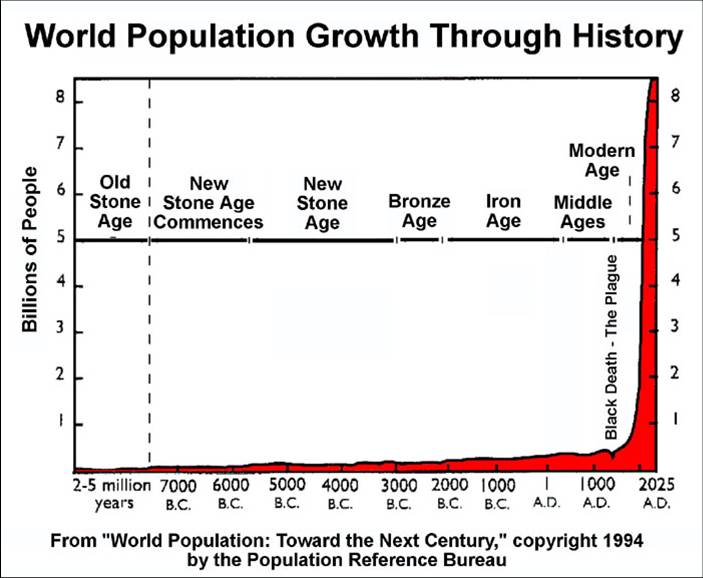
Here’s the famous hockey stick graph showing human population growth through time. The plague shows a little dip, then the industrial revolution, and here we are, hanging precipitously.
Many advocate a return to pre-industrial practices, and since industry runs on cheap fossil fuel, that’s a distinct possibility. But, will we still adversely impact the natural world without industry?
We were causing large scale environmental destruction long before the Industrial Revolution.
Let’s go all the way back to the beginning—to the Old Stone Age, shown on the far left of the graph.

Homo erectus existed for over a million years before evolving into Homo sapiens. This male is sharpening his spear, and it looks like he’s got a plan: “Kill food. Get woman.” Men have come a long way since then.

Our serious impact on natural ecosystems began when we started setting fires to flush out game and improve hunting. Ecosystems were altered and species may have been driven to extinction. Before Prometheus gave us fire, our only tools for around 800 thousand years were simple chopping stones, and we were a part of the web of life. Maybe his mythical punishment was well-deserved.
Around 200 thousand years ago, Homo became sapiens, Latin for wise. Later we would get so wise we became Homo sapiens, sapiens. We continued pursuing the primitive lifestyle, which neo-primitives advocate we return to for the good of planet and people. This would only be possible with a global population of a few hundred million at the most. Fewer, if we were to avoid reducing the populations of other species.
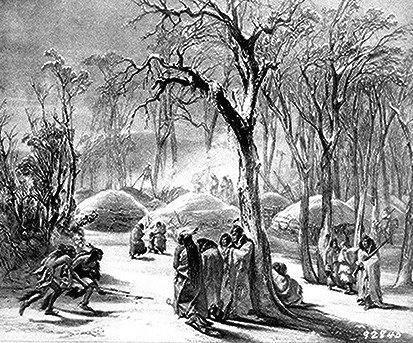
The many cultures of what we now call the Americas have been idealized as examples how we could live in harmony with nature. We certainly have a lot to learn from what’s left of these cultures. Adopting the First People’s environmental ethics and lifestyle would be possible only with a greatly improved population density.
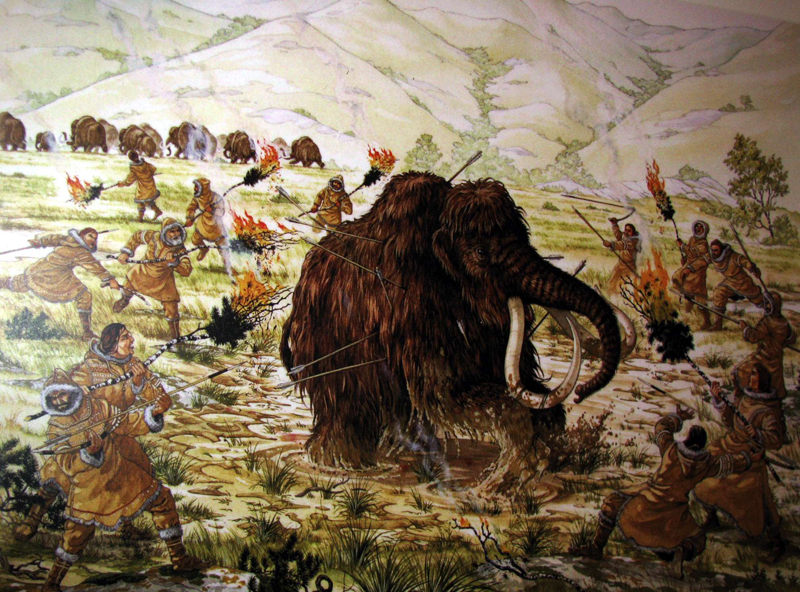
Their cultures evolved from the first wave of humans to arrive from Asia. They learned by experience that animals can be hunted to extinction, and they developed a profound respect for non-human animals. Maybe our culture will develop renewed respect for other animals as more disappear.
Hunting adult mammoths makes a dramatic painting, but it’s likely they hunted the young ones more.

They’re easier to kill and just the right size for the tribe. With a gestation period of two years and only one or two born to fertile females at a time, herds would shrink and disappear in a relatively short time.
Debate continues on the role of early humans in mass extinctions of North America, but paleontologists may have found the smoking gun for mammoth murders. Tusks of the most recent female mammoths reveal unnatural amounts of time spent pregnant, indicating excessive deaths of their young.

Agriculture was developed independently in at least three parts of the world: the Middle East, Asia, and the Americas. Many point to farming as the wrong turn for our species and for Earth’s biosphere. We were healthier and our environments were healthier when we lived as small bands hunting and gathering. Most of our evolution to modern humans occurred in this phase, and it’s still the way our brains work. Now we hunt for bargains and gather debts.

We’ve been huddling around the fire, bonding as a family for a million years.

Fire was burned into our consciousness before we evolved into Homo sapiens, but in the last sixty years it has been eliminated from homes in over-industrialized regions such as ours.

Instead of huddling around a family fire, we huddle around a family TV. Our loss of fire may be a major cause of our feelings of separation from the natural world, though we may not be conscious of how much we miss it.

The family hearth is also becoming a luxury in agrarian regions as wood becomes scarce and is used mainly for cooking.
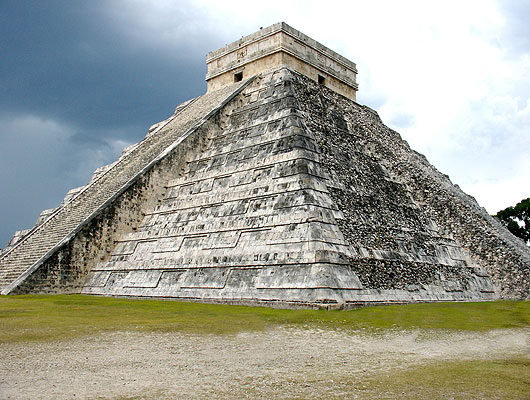
After the initial spasm of extinctions in the Americas, which occurred everywhere modern humans invaded, cultures developed and grew into empires. Populations naturally grew with their food supplies, and forests were cleared to grow that food.

A pyramid makes the perfect emblem of human civilization. We have perpetrated pyramid schemes from the beginning. As a tribe increased its number of hunters and gatherers, more area was needed to hunt and gather, so they spread out. When there wasn’t enough land to spread out on, we developed agriculture, giving us more food and more field hands to grow more food. Still more land was needed and wars determined which culture got it. Empires grew dependent on growth, until the pyramid scheme got too big and inevitably fell apart.
When we developed economic systems they followed the same form. Lately we’re calling them bubbles, because pyramid schemes are illegal. We had a dot com bubble, a housing bubble, financial derivatives bubble, and now alternative energy looks like an investment with good growth potential.
But, back to the people of ancient empires, who didn’t have our sophisticated systems and MBAs.
They developed agriculture and food storage, which allowed them to increase their populations, which required more land, which lead to deforestation and over-farming. They increased their food supply, proving the paleo-Malthusian alarmists wrong. We’ve got neo-Malthusians so why not paleo-Malthusians?
Their Green Revolution was only temporary and agriculture couldn’t keep up with ever increasing demand. Maybe those elaborate human sacrifices to their sun god provided nutrition for some. Pollen analysis of sediment cores from ancient lake beds reveal complete deforestation just before the Mayan empire’s collapse.

Where the Mayans flourished is now called Guatemala, and forests are again being cleared to keep up with an increasing population.

“A message from 900 A.D.: it’s never too late to learn from your ancestors.”
A NASA scientist has identified ancient canals which the Maya likely used to drain a swampy area so they could farm it. He’s promoting the same plan to avoid the deforestation which contributes to global warming. Problem solved, for a little while. Guatemala’s fertility rate is three point five, and at this rate their 13 million people will double in 35 years.
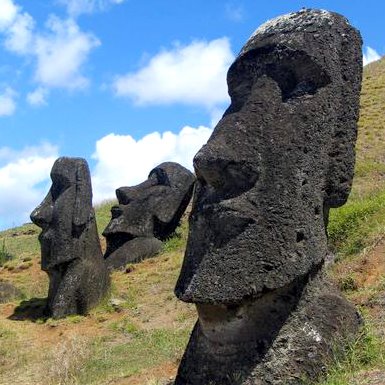
The rise and fall of empires has been repeated all over the planet for thousands of years, and the same pattern continues today. The two main differences are that now we are connected globally—it’s a global civilization—and there have never been this many of us in existence at the same time.

The Green Revolution helped reduce the famines Paul Ehrlich warned of in The Population Bomb in 1968. Another neo-Malthusian proved wrong.
In 1970, when the global human population stood at 3.7 billion, the main architect of the Green Revolution, Norman Borlaug, said:
“There can be no permanent progress in the battle against hunger until the agencies that fight for increased food production and those that fight for population control unite in a common effort. Fighting alone, they may win temporary skirmishes, but united they can win a decisive and lasting victory to provide food and other amenities of a progressive civilization for the benefit of all mankind.”
Instead, all the increased agricultural yield has been gobbled up by population growth. Food production has almost kept up with us, but at a huge ecological cost. Farming on performance-enhancing drugs produces more food, but it’s at the expense of long-term fertility of the soil.
Jared Diamond, in his book Collapse, outlined why civilizations fail.
Fail to anticipate problems:
no experience with situation, forgetting experiences of past,
misinterpreting/misapplying experiences of the past
Fail to perceive existing problems:
imperceptible, creeps up, decision makers removed [out of touch], trend
hidden by ups and downs
Rational bad behavior:
just business, greed, power lust,
Disastrous values:
failure to rethink religious and cultural values
Denial of problem
Can’t solve problem
Our population growth incorporates all these reasons except, potentially, the last one. We do have the ability to solve our density problem, however, the other five reasons combine to reduce our chances of success.
“We fail to anticipate problems”
Our ancestors didn’t foresee a time when there were more of us than the land could support, though many of them had experienced it, becoming refugees as a result. In prehistoric times, a lack of resources drove tribes to risk their lives migrating to unknown lands, and in modern times, those same pressures drive millions to seek places they can earn enough to raise their families.
“We misinterpret or misapply experiences of the past” The NASA site reminds us, “It never too late to learn from our ancestors,” but we use satellite imagery to make exactly the same mistakes they made: we fail to perceive that it’s our excessive breeding which creates this hardship, not a lack of farmland.
“We engage in rational bad behavior”
Corporations are required to maximize profits for their shareholders, so naturally, they engage in amoral activities.
Couples may understand that there are more people than resources, that the future isn’t what it used to be, but self-centered and short-sighted behavior causes them to disregard the evidence. Besides, “Why should I be the one to deny myself the baby I’ve always wanted?”
Governments may also be aware that there are too many of us, but reproduction is encouraged in hopes of sustaining an unsustainable economic system a little while longer.
An unwillingness to rethink cultural values might be our most significant failure in these times. It prevents us from perceiving the underlying reason for all our problems.
Collectively, we go to great lengths to assign obvious population problems to other causes. Traffic jams? Not enough roads. Hunger? Food distribution needs improving. Energy costs raising due to energy shortages? Need more energy sources—renewable if you’re an environmentalist.
We have the ability to solve our breeding problem and Diamond offers two main elements we might use to do so:
“Thinking long-term and reconsidering core values.”
This is something we as individuals need to practice as well. It’s easy to get tunnel vision if we don’t rethink what we think.
I was hosting an information table for VHEMT, offering this bumper sticker from another organization.
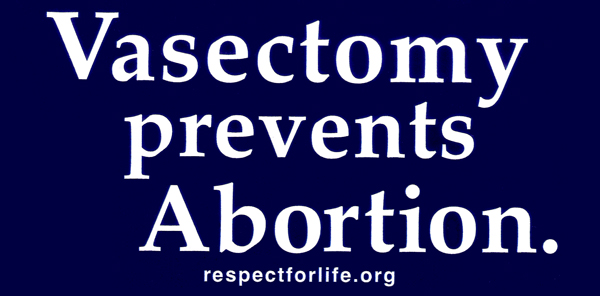
Simple statement of truth, well-received by visitors. But then a woman walked past and jabbed the sticker with her finger and stated, “I don’t like that, I’m pro-choice.”
I was speechless. It’s true that getting a vasectomy and not causing an unwanted pregnancy deprives a woman of her right to get an abortion, but...
So I’ve been trying to rethink some of my values to avoid tunnel vision, or at least to recognize it when it happens. Like the question I was asked by a newspaper reporter, from Scotland, “What would you do if you had a magic wand?” I said I would render all Homo sapiens sperm inviable. Giving the whole world a virtual vasectomy.
Well, that would achieve our phase out, probably peacefully though not voluntarily, but it’s a very narrow vision when you’ve got a magic wand.
There’s no magic wand and there never will be one, just as we won’t get to decide where to set global contraceptive pressure, but these thought experiments help us rethink core values.

Why not cause our species to evolve so that we don’t have to go extinct? Just wave the wand and make us compatible with Earth’s biosphere again. Now we just have to determine which human trait to either eliminate or to accentuate. Is there one trait that makes us so deadly to all life, including our own? Is there an improvement that would allow us to continue existing as Homo sapiens?
I’d like to begin the question and answer session, which follows shortly, with your thoughts on this.
In the meantime, what are our core values we need to rethink as a society?
As we mature as individuals, our realm of concern expands from ourselves as infants, to our parents, to our family, community, nation-state, and to humanity as a whole. We’re still concerned about the smaller divisions of humanity when we think of the whole world as our family. The trouble is, we have a tendency to stall along the way.
Nationalism and patriotism are instilled by most cultures as positive values, but they inhibit our advancement to the next level of empathy. As the world becomes more connected, it’s easier to relate to people in other regions, and many more than ever before are doing so.
But this is where we collectively get bogged down: our own species is the one we care about at the expense of other species. I think this is a core value we need to rethink.
We need to keep on expanding our concern to include non-human species, and on to concern for Earth’s biosphere as a whole. We’ll still care about humanity, just as we care about our families while caring about our communities and the human family.
The full title of Collapse includes “How societies choose to fail or succeed.” Although none have succeeded over time, “How societies choose to fail” would make a depressing book title. We like a little optimism, some hope for the future.
Diamond defines success as “a society’s ability to sustain itself over time, without exploiting the environment to the point of collapse.”
He offers Japan as a modern example of success because they’re preserving their forests. However, Japanese companies are clearcutting forests in other places, whaling in whale sanctuaries, and so on. I don’t think exporting ecological destruction and importing the resources counts as success.
But my main objection to this spelling of success is that it’s human-centered: an ecosystem’s value is determined by how much we can exploit it, not as something worthy of respect in its own right.
The definition could be shortened to, “society’s ability to sustain itself over time, without exploiting the environment,” period. The environment being Earth’s biosphere, hydrosphere, atmosphere, and lithosphere.
When we think of our species as one of the millions sharing planet Earth rather than the species that this was all created for, our long-term thinking will put Earth first.
Physical
Social
Personal
I got this from Paul Ehrlich. We’re still evolving physically, but it’s so slow that we may as well disregard it. We haven’t changed significantly in tens of thousands of years. Maybe Monsanto could reduce our ecological footprints by genetically engineering humans who are only a foot high. Just think of the number of people Earth could support then.
Social evolution has always lagged a generation or two behind the times. Things are changing so fast today that social traditions and institutions are inadequate for coping, but society as a whole clings to obsolete values based on a world that doesn’t exist any more.
Personal evolution can happen instantly, and it often does. Influences may take a long time to accumulate before we make a change, but the change can be comparatively fast—when we’re ready for it.
And speaking of change... Gandhi said, “You must be the change you want to see in the world.” [Turns out this has been attributed to Gandhi.]
Is it likely that enough of us will choose to stop breeding to avoid a collapse of civilization or the biosphere? Probably not, but it’s still the right thing to do. It’s the change we in the Voluntary Human Extinction Movement would like to see in the world.
Thank you all for coming tonight and I hope you’ll stick around for my favorite part, the questions and answers.
The following are a few of the questions and my answers as best I can remember. They aren’t in the original order.
What about a cap and trade system? Organizations which want to reduce births could buy up breeding rights. Couples who want to have more than the allotted amount would have to buy that right from someone who doesn’t want to breed.
No, it’s not a good idea because it would discriminate against poor people and the rich wouldn’t be affected.
If we’re headed for involuntary extinction anyway, why not just let that happen?
Yeah, maybe we should make more of us to bring about our extinction faster. It’s like heading for an embankment and not worrying about stopping because we’ll stop as soon as we hit it. We have brakes and brains and I think we should use them.
Why extinction and not just a sustainable population size?
[I forgot to state the distinction between VHEMT Supporter and VHEMT Volunteer at the beginning of this talk, so I did so in answer to this question].
Do you eat meat?
No, but some in VHEMT do. When someone wants to reduce their environmental impact, giving up meat is one way. And some might not drive a car. But head and shoulders above—maybe adding all those together—is not creating another of us. Each of us uses 24 acres of potential wildlife habitat, so each new human we don’t create preserves that much. I’ve decided to not make 10 more people so I’m saving 240 acres.
Can you break down that 24 acres?
Yes, it’s from the The national footprint network. They break it down by country and then by elements: carbon, land use, fishing...
What about last humans? Who will take care of them?
Yeah, no one to change their catheter. If we plan ahead we should be able to deal with that. We would be healthier because the environment will be healthier. Even if we aren’t able to prepare for that, fewer people would be suffering at the end of life than are now.
What will happen to domesticated animals dependent on us?
Domesticated animals would be phased out as we go, hopefully long before that. There won’t be herds of cattle in feedlots: “Where are our humans, we’re hungry.” The original cow, the aurochs is now extinct. It’s tragic.
Do you think we should try to find aliens?
Space aliens, or...
Yes, I mean space aliens.
Well, the Ferme paradox asks, if there are space aliens, where are they. The answer could be that intelligence selects against itself. We’ll blow ourselves up before we develop space travel.
Do you think homosexuality will help with The Movement?
There aren’t really enough. Ten percent? It’s a good start. [Pope Benedict says blurring gender lines could lead to human extinction.]
Another species will come along and be just as bad or worse. We might stick around and prevent that from happening.
It would be great if we could evolve to fill that role. No other species has caused this many species to go extinct—the fossil record doesn’t show it. We’re causing more extinctions than at any time in the past 65 million years. There’s a theory, the super predator theory. Occasionally a predator gets so good at being a predator that it wipes out its food supply and goes extinct.
Why does an ecosystem have more value than humans? After we’re gone there would be no one to give it value.
Well, true, the concept of value is a human one and when we’re gone it won’t be needed. There won’t be whales talking about whale values. We aren’t as important as the planet, just as a toe is not as important as a body. The biosphere would do just fine without us, but if the microscopic bacteria in the intestines of termites went extinct, the entire web of life would be in trouble.
Why should we try to preserve ecosystems? Do they have intrinsic value?
Maybe and maybe not, but it’s not for us to decide. We have no right to decide that they don’t have value. It’s not so much about preserving ecosystems as not destroying them.
Is there any legislation or policy you would favor instead of a voluntary approach?
Legislation which promotes reproductive freedom. Laws which make it possible for anyone who doesn’t want to breed to not do so. There are restrictions on our reproductive freedom in this country. I often hear from men in their early 20s who want to get a vasectomy and they can’t find a provider. They’re old enough to breed but not old enough to decide not to breed.
If educated and intelligent people die off without having children, won’t there be a dumbing down?
Like the movie “Idiocracy.” Maybe that happened a long time ago. Awareness is not inborn so we can help existing children learn. We don’t have to create new vessels to fill with our ideas.
Is education important to getting people to become VHEMT?
Not really. It doesn’t take a lot of education or even intelligence to figure this out. I’ve heard from people who say they figured this out as 6-yr-olds.
Do you have any children?
Since we’re all in the human family, I have two billion children and some of them aren’t doing too well. I haven’t produced any biologically, but I don’t mean to take the moral high ground. There are plenty of people in The Movement who have had children. They just figured it out later.
If you want to prevent extinctions why are you promoting human extinction?
Yeah, it’s a paradox, huh? We’re the only species that could voluntarily choose to go extinct, or which has reason to.
